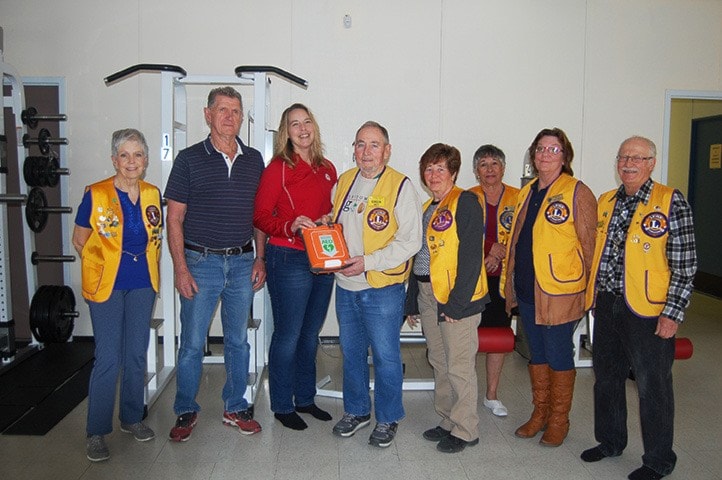There are two new automated external defibrillator (AED) units in Ashcroft, thanks to the Ashcroft and District Lions Club: one in the Ashcroft Volunteer Fire Department’s Rescue One vehicle, the other at Merv’s Gym at the Ashcroft HUB. And one of the Lions who made the presentations, past president Nick Lebedoff, knows better than most how critical these units can be in saving lives.
“I’ll never forget that date,” says Lebedoff. “That date” was February 14, 2014, when he was taking part in a seniors’ fitness class at Cache Creek Community Hall. Vicky Trill, now site manager at the HUB, was leading the class. “We had an Olympic-themed class that day,” she recalls, that was inspired by the Winter Olympics in Sochi, Russia that year. “Nick was on a ‘luge’ [a small wheeled cart] doing an obstacle course when he had a heart attack.”
Trill begin administering CPR; then Judy Roy brought the AED that was at the site, and began using that. “I was gone for 15 minutes,” says Lebedoff. “My heart came to a dead stop. When it was found that there was an AED in the hall, Judy used it and brought me around.”
Cardiopulmonary resuscitation, or CPR, is an emergency procedure that involves chest compression—often paired with artificial ventilation—in an effort to manually preserve intact brain function until further measures are taken to restore spontaneous blood circulation and breathing in a person who has gone into cardiac arrest.
While the procedure is an important one, studies have shown that when CPR is combined with the use of an AED, the survival rate increases dramatically. “They really make a difference,” says Trill.
Vivian Edwards, secretary-treasurer of the Lions Club, says that Paché Denis of the Ashcroft/Cache Creek Rotary Club told her that Canadian Pacific Railway was awarding grants of up to $1,000 for any program that involved heart health. Edwards wrote to CP and said that there were two places in town they wanted an AED for: the fire department, which did not have one, and Merv’s Gym at the HUB. Funding for both was confirmed by CP.
“It was a very easy decision to make,” says Edwards. “They [the HUB] already have one at the front of the building, but we thought the gym should have one, because it’s a long way from there to the front.” Use of an AED within the first two to three minutes of an incident is critical not only in saving lives, but in preventing lasting brain damage.
“We’ve never had an AED,” says Ashcroft fire chief Josh White. “It’s for people we might rescue, or for ourselves. The number one killer of fire fighters on the fire grounds is a heart attack. Having this is great for us; I give a huge thank you to the Ashcroft and District Lions Club.”

Members of the Lions Club present an AED to Ashcroft Fire Chief Josh White. Photo by Barbara Roden.
Lebedoff was in favour of the other AED going to Merv’s Gym. Trill says that while she hopes no one has to use it, it could save a life. She also notes that all the schools in School District No. 74 that have high school students have received an AED, and teachers have been instructed so that they can teach students in Grades 10–12 how to administer CPR and use the AEDs.
“Almost anywhere in our town you should be able to find an AED within that two minute window.”
“I’m very competitive,” says Lebedoff, recalling his “luge” event in 2014. “Afterwards my doctor said to me ‘You’re 68, not 18.’” It took him a year after the heart attack to slow down, but that caused stresses of its own.
“I’ve always been active, always volunteered, and not doing that was stressful,” he says. “I’ve had to find a happy medium.”
Part of that happy medium involved “giving back” by taking the St. John’s Ambulance level C training for CPR and AED use. “I haven’t had to use it,” says Lebedoff of the training. “But I believe you always give back to someone who helped you out.”
